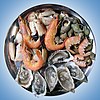Tuna
| Tuna | |
|---|---|

| |
| Tunas (from top): albacore, Atlantic bluefin, skipjack, yellowfin, bigeye | |
| Scientific classification | |
| Domain: | Eukaryota |
| Kingdom: | Animalia |
| Phylum: | Chordata |
| Class: | Actinopterygii |
| Order: | Scombriformes |
| Family: | Scombridae |
| Subfamily: | Scombrinae |
| Tribe: | Thunnini Starks, 1910 |
| Genera | |
| |
Tuna, sometimes called tuna fish, are several species (kinds) of fish. They are in the family Scombridae, mostly in the genus Thunnus.
Tuna are fast swimmers. People have seen tuna swim at up to 77 km/h. Several species of tuna are warm-blooded. Most species of fish have white flesh. The flesh of the tuna is different. It is pink to dark red. This is because tuna muscle tissue contains greater quantities of myoglobin. Myoglobin is a molecule that binds oxygen. Some of the larger tuna species such as the Northern bluefin tuna can raise their blood temperature above the water temperature with muscular activity. This enables them to live in cooler waters and survive a wider range of circumstances.
History
[change | change source]Tuna fishing plays a vital role in the economy, food security, and culture of many coastal communities worldwide. Looking at the history of the art of tuna fishing, it is important to know where the origins of this practice come from. The organized exploitation of tuna began when somebody invented the tuna traps and fish factories linked to them. In the Mediterranean Sea, and the Atlantic Sea, it is to our knowledge that the Phoenicians were the ones who started this industrial activity. The Greeks, in the Black Sea and the Aegean Sea, followed the Phoenician lead. Eventually, tuna fishing spread to the Atlantic Spanish areas close to Gibraltar.
One of the more conniving factors that makes us aware that the Phoenicians were one of the first to industrialize the art of tuna fishing, is the archaeological remains that are found in their cities. As commonly known, salt was one of the first strategies that fishermen used to preserve fish. The Phoenician's large-scale tuna fisheries and salting pits traveled with them as they spread out across the Mediterranean. Today, ancient tuna salting pits are being excavated next to the archaeological sites of Phoenician origin.
The Phoenicians are very well known for being "cunning seafarers." Due to their skills in vessel making, they were able to make a ship that was great for fishing, especially for tuna fishing. It is to be assumed that Phoenician ships had dozens of amphorae tied to each other in the holds of ships. The amphorae would act as a key part in the preserving of the tuna but were also used to help direct the vessel as it traveled.
Commercial
[change | change source]Tuna is an important commercial fish. Some varieties of tuna, such as the bluefin and bigeye tuna are threatened by overfishing, dramatically affecting tuna populations in the Atlantic and northwestern Pacific Oceans. Other populations seem to support fairly healthy fisheries (for example, the central and western Pacific skipjack tuna), but there is mounting evidence that overfishing threatens tuna fisheries worldwide.
Some fishermen in Australia now grow Southern bluefin tuna in fish farms. Fish farms are areas of water with nets around them, where farmers raise (keep and grow animals) fish. Some tuna farms are circular nets 40 meters in diameter and 20 meters deep. The fishermen catch the tuna at sea, and then they keep the tuna in these farms. The tuna grow and get fatter for three to six months. There are also tuna farms in the Mediterranean, North America, and Japan that raise Northern bluefin tuna. Some environmental groups say that tuna farms use too much fish as food for the tuna, and that the farms pollute the water (make the water dirty).
Diets
[change | change source]Tuna are high up in the food chain. They eat animals that ate animals. Their diet leads to the accumulation of heavy metals in their flesh. Mercury levels can be relatively high in some of the larger species of tuna such as bluefin and albacore. As a result, in March 2004 the United States FDA issued guidelines recommending pregnant women, nursing mothers, and children to limit their intake of tuna and other types of predatory fish [1] Archived 2007-05-19 at the Wayback Machine. However, most canned light tuna is skipjack tuna and is very low in mercury.
Sport fishermen like to catch tuna using rods and hooks.
Species
[change | change source]There are eight species:
- Albacore, Thunnus alalunga (Bonnaterre, 1788).
- Yellowfin tuna, Thunnus albacares (Bonnaterre, 1788).
- Blackfin tuna, Thunnus atlanticus (Lesson, 1831).
- Southern bluefin tuna, Thunnus maccoyii (Castelnau, 1872).
- Bigeye tuna, Thunnus obesus (Lowe, 1839).
- Pacific bluefin tuna, Thunnus orientalis (Temminck & Schlegel, 1844).
- Northern bluefin tuna, Thunnus thynnus (Linnaeus, 1758).
- Longtail tuna, Thunnus tonggol (Bleeker, 1851).
Related pages
[change | change source]Species of several other genera (all in the family Scombridae) have common names containing "tuna":
- Skipjack tuna Katsuwonus pelamis
- Slender tuna Allothunnus fallai
- Bullet tuna Auxis rochei rochei
- Frigate tuna Auxis thazard thazard
- Kawakawa (little tunafish or mackerel tunafish) Euthynnus affinis
- Little tunny (little tunafish) Euthynnus alletteratus
- Butterfly kingfish (Butterfly mackerel) Gasterochisma melampus
- Dogtooth tuna Gymnosarda unicolor
References
[change | change source]- "Thunnus". FishBase. Ed. Ranier Froese and Daniel Pauly. January 2006 version. N.p.: FishBase, 2006.
- Natale, A Di. “The Ancient Distribution of Bluefin Tuna Fishery.” THE ANCIENT DISTRIBUTION OF BLUEFIN TUNA FISHERY: HOW COINS CAN IMPROVE OUR KNOWLEDGE, iccat.int/Documents/CVSP/CV070_2014/n_6/CV070062828.pdf. Accessed 10 May 2024.
- Adolf, Steven. “The Purple Folk’s Tuna.” SpringerLink, Springer International Publishing, 1 Jan. 1970, link.springer.com/chapter/10.1007/978-3-030-20641-3_3.


